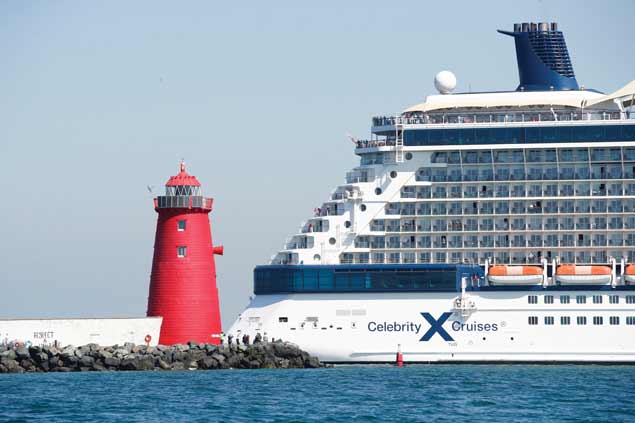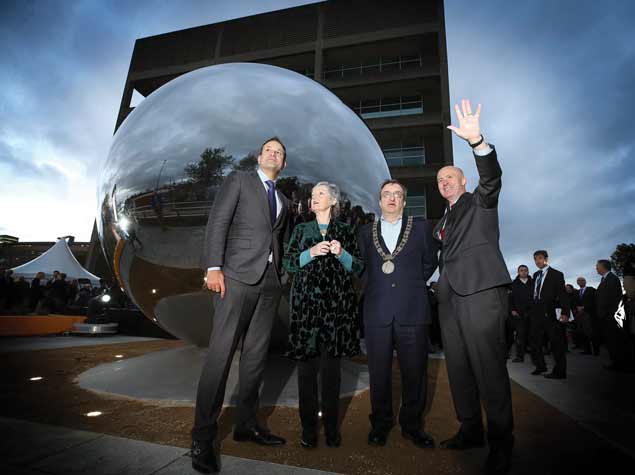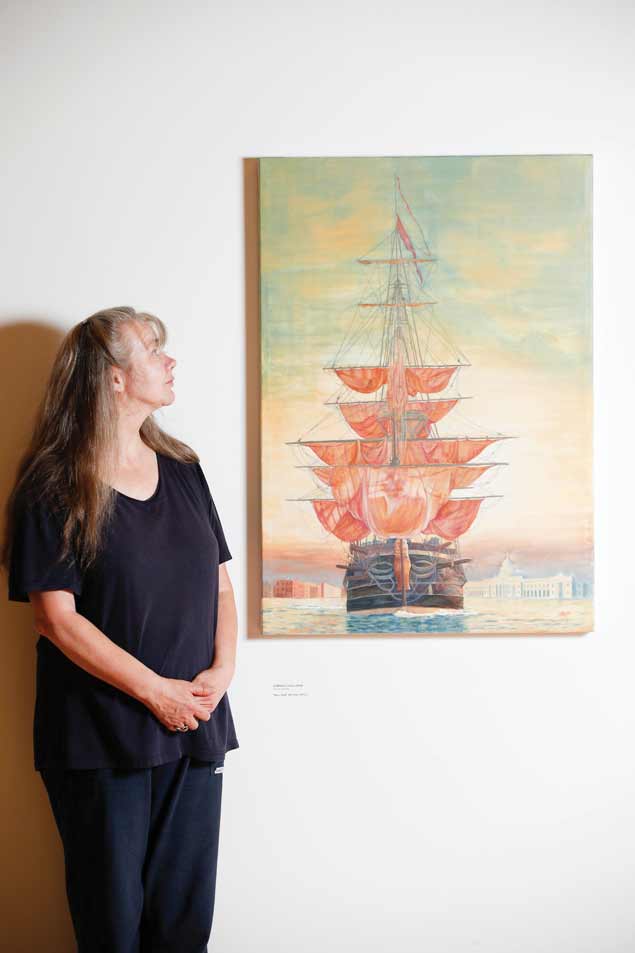2017 has been a very productive year for Dublin Port. There has been sustained, significant growth across the business, from cargo to cruise, and it has also been a year of firsts on a number of fronts.
Trade
Latest trade figures show growth of 4.2% to the end of Q3 2017. A continuation in the current rate of growth to year–end would see 2017 become a third successive record year for Dublin Port. Total throughput (imports and exports) for the nine months to the end of September was 27.1 million gross tonnes, with 5,932 ship arrivals during the period. This is the fifth year in a row for Dublin Port to see substantial growth in the first nine months. Within that, growth was particularly strong in Ro-Ro freight with 736,462 units in the first nine months, an increase of 5.3% on the previous year. Meanwhile Lo-Lo containers grew by 4.1% to 515,718 TEU. Overall, volumes in Dublin Port have grown by 30.1% in just five years.
Infrastructure Development
With a return to the trend of year-on-year increases seen in the decades before the crash of 2008, and five years of consistent growth, works to increase the capacity of Dublin Port are advancing on the basis that growth will continue for many years to come. Works progressed throughout 2017 on both the Alexandra Basin Redevelopment (ABR) Project and the development of Dublin Inland Port located on a 44-hectare site just 14km from the Port. During the year, we also turned our attention to our next major project which, like all major port development projects, is being guided by Dublin Port’s Masterplan 2012-2040. The next significant project will focus on providing much needed additional capacity for Ro-Ro freight and container traffic to the UK, and increasingly to Continental Europe.
 The 317m Celebrity Eclipse cruise arriving in Dublin on May 10 carrying over 4,000 passengers and crew on her maiden call to Ireland. The new arrival marked the start of Dublin Port’s 2017 cruise season that saw 130 cruise calls confirmed for Dublin Port this year, bringing over 200,000 passengers and crew to visit the city and benefit the local economy. Celebrity Eclipse will return to the city in 2018 when she becomes the first ship of a major cruise line to call Dublin Port a ‘home port’ Photo: Conor McCabe
The 317m Celebrity Eclipse cruise arriving in Dublin on May 10 carrying over 4,000 passengers and crew on her maiden call to Ireland. The new arrival marked the start of Dublin Port’s 2017 cruise season that saw 130 cruise calls confirmed for Dublin Port this year, bringing over 200,000 passengers and crew to visit the city and benefit the local economy. Celebrity Eclipse will return to the city in 2018 when she becomes the first ship of a major cruise line to call Dublin Port a ‘home port’ Photo: Conor McCabe
Homeporting - A New Departure
Four consecutive years of rising cruise tourism passengers to Dublin Port, and maiden calls by leading cruise lines, including MSC Cruises’ MSC Splendida, Holland America Line and Disney Cruise Line, have cemented Dublin Port’s position as a marquee cruise tourism destination on international passenger itineraries. Confirmation that Celebrity Cruises will base a number of Celebrity Eclipse turnarounds in Dublin next year, and news this year that one of the company’s newest Solstice class ships, Celebrity Reflection, will also homeport from Dublin in 2019, highlight growing momentum for turnaround cruises in the capital and, with that, bright prospects for the city’s wider tourism offering.
Opening Up Port Centre
An emerging port heritage trail now forms part of the city’s own tourism offering, and 2017 has been a landmark year in furthering its development with the opening up of Port Centre. The new public realm surrounding the company’s headquarters on Alexandra Road marks the largest physical intervention by the company to reintegrate Dublin Port with the city in 35 years and follows the reimagining of Dublin Port’s Diving Bell on Sir John Rogerson’s Quay.
The stone wall boundary surrounding Port Centre has been removed at intervals and replaced with new gate-like structures made from pre-rusted Corten steel. Opened, the gates reveal a newly reconfigured public plaza featuring a four-tonne stainless steel ball inspired by the Time Ball, which originally stood on the roof of the Ballast Office at the corner of Aston Quay and Westmoreland Street, and would drop to signal Greenwich Mean Time to ships in port.
Completing the new environs of the 1981 Scott Tallon Walker building is Crane 292, a refurbished 1960s Stothert & Pitt crane that once served as a workhorse, loading and unloading bulky material from ships at Alexandra Quay from 1964 through to its retirement in 1997. Restored to its former glory, Crane 292 is illuminated at night, providing a new addition to the docklands skyline.
 An Taoiseach Mr. Leo Varadkar TD, (left) with Lucy McCaffrey, Chairperson of Dublin Port Company, Lord Mayor of Dublin, Mícheál Mac Donncha and Eamonn O’Reilly, CEO, pictured after unveiling the new art insulation entitled “The Sphere” at the official ‘opening up’ of Port Centre following completion of a 12–month project to soften the Port’s boundaries with the city Photo: Conor McCabe
An Taoiseach Mr. Leo Varadkar TD, (left) with Lucy McCaffrey, Chairperson of Dublin Port Company, Lord Mayor of Dublin, Mícheál Mac Donncha and Eamonn O’Reilly, CEO, pictured after unveiling the new art insulation entitled “The Sphere” at the official ‘opening up’ of Port Centre following completion of a 12–month project to soften the Port’s boundaries with the city Photo: Conor McCabe
New Perspectives on Port – River – City
The modern port, its rich history and links with Dublin City and the River Liffey provided the inspiration and theme for Port Perspectives, Dublin Port’s visual arts commissioning series throughout 2017. During the year, the works of acclaimed Belgian artist Eugeen Van Mieghem went on display to Irish audiences for the first time in a major new exhibition at Dublin City Gallery The Hugh Lane, showing life in the Port of Antwerp at the turn of the 20th century.
Inspired by the exhibition, local community groups and schools saw their own works then go on display in the gallery. Sketches, watercolours, pastels and collages capturing images and memories from life at Dublin Port were created by young and old during a series of Drawing Club workshops. The artists ranged in age from as young as 11 to almost 80-years-old, and represented the communities of East Wall, Ringsend and Pearse Street.
Port Perspectives also featured new artwork from commissioned artists, including Sheelagh Broderick, whose Port Walks podcasts give recreational walkers along the Great South Wall an insight into working life aboard the vessels that enter the Port each day. Silvia Loeffler’s Transit Gateway mapped the changing shape of Dublin Port over the centuries, from its beginnings as a medieval shoreline to present day, in a series of seminars and accompanying artworks, while site-specific moving image installations were curated by Alice Butler & Daniel Fitzpatrick of Aemi and artist Cliona Harmey.
Ro-Ro in Focus
In a new development, CLdN’s MV Celine, the world’s largest Ro-Ro freight vessel, made her maiden call to Dublin Port in October, marking the start of a new service between Dublin and the ports of Zeebrugge and Rotterdam. With a capacity of 8,000 lane-metres carrying over 600 freight units, she will provide additional capacity and flexibility for customers trading with Continental Europe, particularly post–Brexit.
 Dympna O'Halloran viewing her art work hung in Dublin City Gallery The Hugh Lane as part of Dublin Port's Port Perspectives Drawing Club Project in Ringsend and Irishtown Community Centre. More than 30 aspiring artists from Dublin's north and south inner city saw their art work displayed in Dublin City Gallery
Dympna O'Halloran viewing her art work hung in Dublin City Gallery The Hugh Lane as part of Dublin Port's Port Perspectives Drawing Club Project in Ringsend and Irishtown Community Centre. More than 30 aspiring artists from Dublin's north and south inner city saw their art work displayed in Dublin City Gallery
In Review
Earlier this year, Dublin Port Company published its report on the public consultation process for the first review of the company’s Masterplan 2012-2040, which makes provision for periodic reviews. The process, which involved extensive outreach to a wide range of stakeholders, will inform the revised Masterplan to be published. In the meantime, Dublin Port Company has undertaken a number of environmental, cultural, leisure and transport studies and assessments arising from the consultation process before finalising the review.
The significant growth of recent years meant that it was timely to review the Masterplan in 2017 and thereby ensure that the framework guiding the Port’s future development continues to reflect changing circumstances such as developments in policies governing planning, national transport, the environment and the economy.
Keep up to date with all the latest Dublin Port News on Afloat.ie here






























































